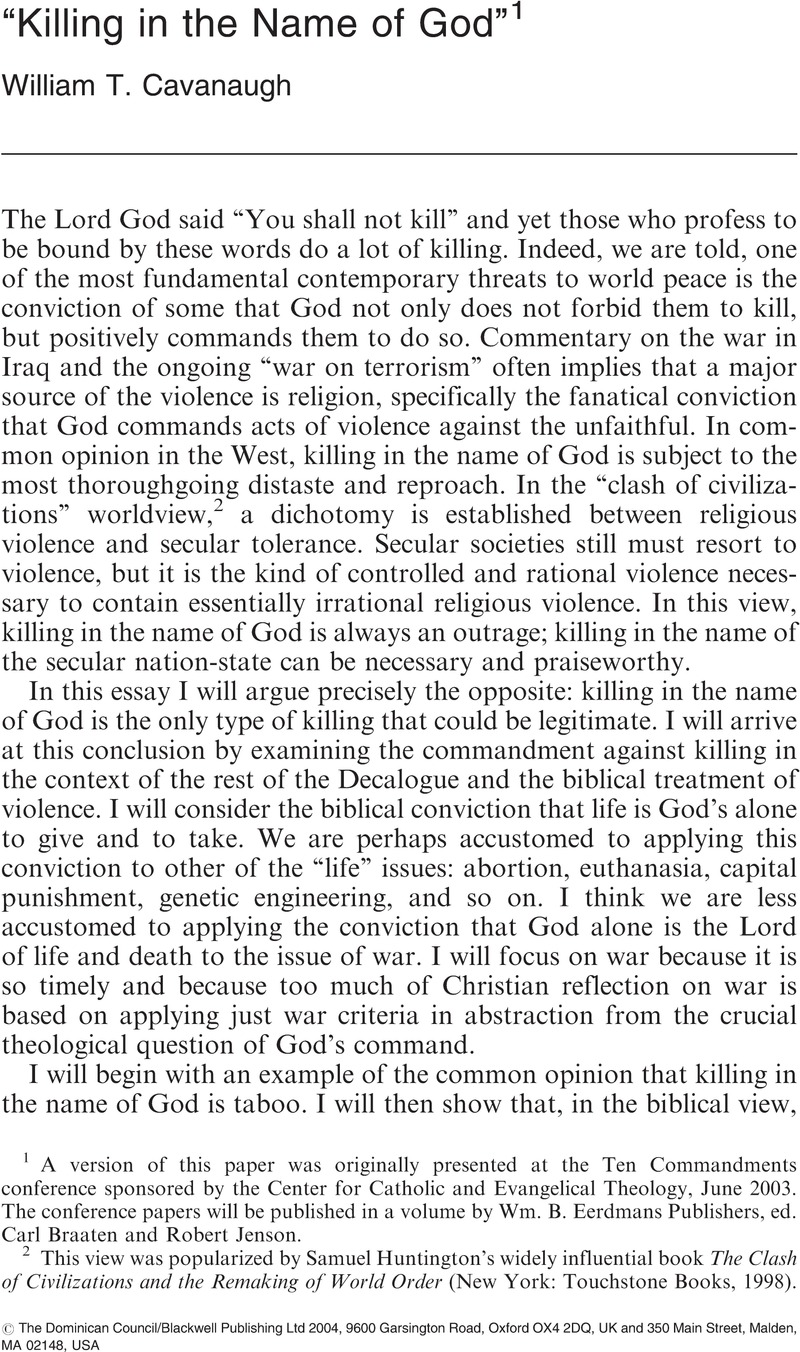No CrossRef data available.
Article contents
“Killing in the Name of God”
Published online by Cambridge University Press: 01 January 2024
Abstract

- Type
- Original Articles
- Information
- Copyright
- Copyright © The Dominican Council/Blackwell Publishing Ltd 2004
Footnotes
A version of this paper was originally presented at the Ten Commandments conference sponsored by the Center for Catholic and Evangelical Theology, June 2003. The conference papers will be published in a volume by Wm. B. Eerdmans Publishers, ed. Carl Braaten and Robert Jenson.
References
2 This view was popularized by Samuel Huntington's widely influential book The Clash of Civilizations and the Remaking of World Order(New York: Touchstone Books, 1998)Google Scholar.
3 Andrew Sullivan, “This is a Religious War,”New York Times Magazine, October 7, 2001, 53.
4 Ibid., 44.
5 Ibid., 45.
6 For an analysis of the media misuse of the term “fundamentalism,” see Jenson, Robert, “The God Wars” in Braaten, Carl E. and Jenson, Robert W., ed., Either/Or: The Gospel or Neopaganism(Grand Rapids, MI: Wm. B. Eerdmans, 1995), 27–30Google Scholar.
7 Sullivan, 46.
8 Fyodor Dostoevsky, quoted in Sullivan, 46.
9 Sullivan, 46.
10 Ibid.
11 Ibid., 47.
12 Ibid., 46–7.
13 Ibid., 53.
14 Stamm, Johann Jakob, with Andrew, Maurice Edward, The Ten Commandments in Recent Research(London: SCM Press, 1967), 98–99Google Scholar.
15 Miller, Patrick D., “The Human Sabbath: A Study in Deuteronomic Theology,”The Princeton Seminary Bulletin 6 (1985), pp. 81–97Google Scholar; Brueggemann, Walter, Deuteronomy(Nashville: Abingdon Press, 2001), 72–81.Google Scholar
16 Barth, Karl, Church Dogmatics III/4 (Edinburgh: T. & T. Clark, 1961), 53Google Scholar.
17 Ibid., 53–4.
18 On this point, see Harrelson, Walter, “Karl Barth on the Decalogue,”Studies in Religion 6, no. 3 (Winter 1976–77): 236CrossRefGoogle Scholar.
19 Phillips, Anthony C. J., “Respect for Life in the Old Testament,”King's Theological Review 6 (Fall 1983): 32–5Google Scholar.
20 Yoder, John Howard, The Politics of Jesus(Grand Rapids, MI: Wm. B. Eerdmans, 1972), 80–2Google Scholar.
21 See Barth, 334–5.
22 Hick, John, “The Non-Absoluteness of Christianity” in Hick, John and Knitter, Paul F., ed., The Myth of Christian Uniqueness: Toward a Pluralistic Theology of Religions(Maryknoll, NY: Orbis Books, 1987), 17Google Scholar.
23 Ibid., 34.
24 Marty, Martin E. with Moore, Jonathan, Politics, Religion, and the Common Good(San Francisco: Jossey-Bass Publishers, 2000), 25–6Google Scholar.
25 Parekh, Bhikhu, “The Voice of Religion in Political Discourse” in Rouner, Leroy, ed., Religion, Politics, and Peace(Notre Dame, IN: University of Notre Dame Press, 1999), 72Google Scholar.
26 Marty, 10–14.
27 Parekh, 74.
28 See Fitzgerald, Timothy, The Ideology of Religious Studies(Oxford: Oxford University Press, 2000)Google Scholar.
29 Sheryl Gay Stolberg, “Given New Legs, Old Proposal is Back,”New York Times, June 4, 2003: A28. See also Carolyn Marvin and David W. Ingle, Blood Sacrifice and the Nation: Totem Rituals and the American Flag(Cambridge: Cambridge University Press, 1999). Marvin and Ingle study American society just as anthropologists study “primitive” societies, and argue that American patriotism is a religion of blood sacrifice that has the flag as its totem symbol.
30 Yoder, John Howard, “Exodus 20:13 –“Thou shalt not kill,”Interpretation 34, no. 4 (October 1980): 396Google Scholar.
31 Ibid., 397–8.
32 Ibid., 397.
33 Barth, 397–400.
34 Ibid., 400.
35 Yoder, The Politics of Jesus, 86–9.
36 Barth, 454.
37 Ibid., 455.
38 Ibid., 433.
39 Ibid., 456–63.
40 Michael Howard sums up the historical evidence of the origins of the state this way: “the entire apparatus of the state primarily came into being to enable princes to make war”; The Invention of Peace: Reflections on War and International Order(New Haven: Yale University Press, 2000), 15Google Scholar; Tilly, Charles says, “War made the state, and the state made war”; “Reflections on the History of European State-making” in Tilly, Charles, ed., The Formation of National States in Western Europe(Princeton: Princeton University Press, 1975), 26Google Scholar. The connection between the liberal nation-state and war is not accidental, for liberal polity is based on tragedy, that is, the ultimate inability of people to agree on the good. In the absence of a shared conception of the good, there is no way to adjudicate disagreements among rival wills nonviolently, so violence can only be displaced, directed against a common external enemy in war.
41 Pope John Paul II, The Splendor of Truth (Veritatis Splendor), paragraph 15.
42 For an analysis of the Vatican's progressive tightening of conditions for justifiable use of force, see William L. Portier, “Are we really serious when we ask God to deliver us from war? The Catechism and the challenge of Pope John Paul II,”Communio 23 (Spring 1996): 47–63. See also Cardinal Joseph Ratzinger, interview with Zenit News Agency, “Cardinal Ratzinger on the Abridged Version of Catechism,” May 2, 2003, at: http://www.zenit.org/english/visualizza.phmtl?sid=34882.
43 I make this argument in detail in my article “At Odds with the Pope: Legitimate Authority and Just Wars,”Commonweal CXXX, no. 10 (May 23, 2003): 11–13Google Scholar.




